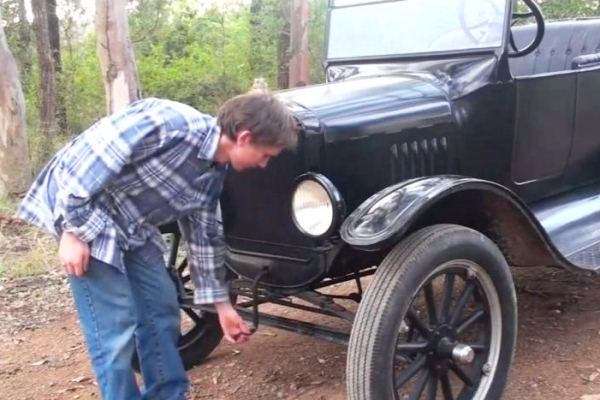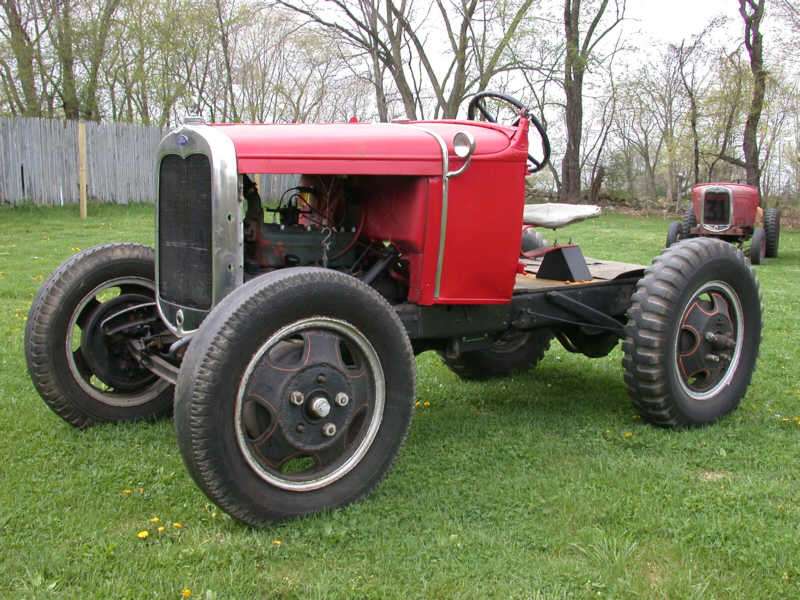Video: How to Start and Run a Model T Ford | Mac's Motor City Garage.com


Posted 16 April 2013 - 10:58

Advertisement
Posted 16 April 2013 - 11:20
Being able to operate a Model T Ford is a core skill for gearheads, like double-clutching or adjusting breaker points. And while the process seems difficult or at least strange, actually it's quite easy and fun. Here's a great little video tutorial.
Video: How to Start and Run a Model T Ford | Mac's Motor City Garage.com
Posted 16 April 2013 - 12:13
Only 85 years too late with that helpful "talkie" Bill....but thanks
Posted 16 April 2013 - 13:23
Posted 17 April 2013 - 04:56
Posted 17 April 2013 - 06:51
Posted 17 April 2013 - 07:02
Edited by RCH, 17 April 2013 - 07:02.
Posted 17 April 2013 - 07:36

Posted 17 April 2013 - 07:47
...however I'm a bit concerned by the position of the starter's thumb in the picture!
I have never mucked around with a T. My motoring history only went back as far as the model A. (I'm second from the left)
Posted 17 April 2013 - 09:35
You seem to have ignored steam altogether, which is disappointing.
Posted 17 April 2013 - 09:59
That was my grandfathers Model A on his farm in the middle of nowhere at Turill NSW.That's a point! It is just one frame from the video, so, like a half-closed eye, it might be fleeting. My father taught me never to have my thumb over the handle.
Great photo, and the unmistakeable gum trees in the background.
Posted 17 April 2013 - 10:37
Pity the person who took the video hadn't got his land legs. Why is it that people wave their bloody cameras around as if they are trying to film a swarm of midges? Rock steady, me, Mr Pan'n'tilt...Live Stim, or Dead Stim?
Posted 17 April 2013 - 10:51
Doesn't seem to want to let me see this video, however I'm a bit concerned by the position of the starter's thumb in the picture! My father, who learned to drive on his father's Model T reckoned you could start them by giving them a kick, a well known music hall act at the time.
Posted 17 April 2013 - 11:29
This is a very well done video. I know from personal experience that it is very difficult to make a video of this type without appearing to be a complete idiot.
I doubt if all Model T's were as well-behaved as this one seems to be .
Posted 17 April 2013 - 15:40
Posted 23 April 2013 - 11:34
That was my grandfathers Model A on his farm in the middle of nowhere at Turill NSW.
He retired the Model A to farm use in about 1960, mum says he drove it to her wedding in 1959. He sold the A in about 1972 for $30.
This photo was taken in about 1968/69 and it was still going well enough to drag a scarifier plough around the 40 acre cropping paddock. (look carefully behind the Model A)

Posted 14 May 2013 - 05:52
Don't know about "doodlebugs" (weren't they the V-1 flying bombs?) but here's one way of achieving tractor-like gearing on a 1915(?) Overland, using the internally geared wheels from an even older horse drawn farm implement.In Australia did you have what we called doodlebugs? Tractor made from Model A Ford or suchlike with two car transmissions in tandem for very low gearing, a shortened wheelbase, and some scheme to fit large-diameter wheels?




Edited by onelung, 14 May 2013 - 05:55.
Posted 14 May 2013 - 06:59
Posted 15 May 2013 - 06:25
Don't know about "doodlebugs" (weren't they the V-1 flying bombs?) but here's one way of achieving tractor-like gearing on a 1915(?) Overland, using the internally geared wheels from an even older horse drawn farm implement.
Advertisement
Posted 15 May 2013 - 08:25
Right hand drive is very common in South Australia. We drive on the left!Incredible! A water-cooled, side valve, inline 4 engine, driving through a rear axle, connected to an open, steel, ring & pinion gear drive at each rear wheel, which have wooden spokes and rims. There also appears to be a drum brake located at each rear axle pinion. And finally, the vehicle has right-hand steering.
Posted 15 May 2013 - 10:12
Quite right too!We drive on the left!
Posted 15 May 2013 - 11:08
Incredible! A water-cooled, side valve, inline 4 engine, driving through a rear axle, connected to an open, steel, ring & pinion gear drive at each rear wheel, which have wooden spokes and rims. There also appears to be a drum brake located at each rear axle pinion. And finally, the vehicle has right-hand steering.
Posted 15 May 2013 - 20:40
Don't know about "doodlebugs" (weren't they the V-1 flying bombs?) but here's one way of achieving tractor-like gearing on a 1915(?) Overland, using the internally geared wheels from an even older horse drawn farm implement.
Posted 16 May 2013 - 00:24
What Mr Overland did not build his cars with a fence post rear axle mount? I am disappointed.1915-ish Overland Model 80, pride of Toledo, Ohio. Note the transmission mounted on the rear axle housing, a common Overland practice. Note also the individually cast iron cylinders; not visible, the outdoor (exposed) valve gear on the other side of the engine. However, I am pretty sure the enormous, hand-hewn dead axle is non-OE fitment.
Pre-1915-ish, many if not most American-built brands were RHD. Pierce-Arrow for one held out with RHD until 1920 or so. Opposing schools of thought...one idea was that chauffeur-operated vehicles should place the servant on the curb side. The major step in standardization was the adoption of LHD in the Model T Ford. Its great success in the marketplace eventually settled the matter. Before the Model T, Fords were also RHD.
Posted 17 May 2013 - 01:58
Mud lubrication.Now that is country engineering. Though lubricating those teeth is a true impossibility.
Posted 17 May 2013 - 03:45
There's the famous and relevant observation "If it is stupid and it works, it isn't stupid".Mud lubrication.
A wonderful piece of re-engineering by the way.
Posted 17 May 2013 - 23:32
Posted 18 May 2013 - 07:52

Posted 19 May 2013 - 10:16
I should have understood this set up before. The wheels drive a harvester, or a super spreader. There was a few around when I was young of various styles. We had a super spreader which was wheel driven. And was set up for a normal tractor drawbar. Worked fine providing you used a constant speed, no stopping or startingI'm guessing that this is the sort of device from which the rear wheels came - not an easy thing to search on the net for anything incorporating "stripper" in its name, BTW...
It's located across the road from the Orroroo garage (go Google it, you non-South Australians) which is a time-capsule gem of a place in itself.
Posted 19 May 2013 - 11:55
Posted 19 May 2013 - 15:21
Posted 19 May 2013 - 17:01
Posted 19 May 2013 - 23:23
With gearing that low just tow it around the block in gear, that should free it. Fresh petrol and we can use it this afternoon to harrow the bottom paddock.I bet we could get that engine running in around an hour -- long as it's not seized up.
Posted 20 May 2013 - 01:21
Posted 20 May 2013 - 10:01
Vinegar and a blow torch.You need tall gearing to free a siezed motor.
Posted 20 May 2013 - 16:48
Vinegar and a blow torch.
Take a google at the E G Staude Manufacturing Corporation of St Paul Minnesota and their Mak-A-Tractor conversions.
Posted 21 May 2013 - 00:28
Tall gearing just drags the tyres.You need tall gearing to free a siezed motor.
Posted 21 May 2013 - 06:50
If you try to clutch start a car in 1st it drags the tyres. Try the same in top gear and it will turn a siezed engine or slip the clutch but it won't drag the tyres.Tall gearing just drags the tyres.
Posted 08 June 2013 - 23:50
Aha! Thread police, eh?Nit-picky technical point I know but this is the "Technical Forum".

Advertisement
Posted 09 June 2013 - 03:46
Posted 09 June 2013 - 06:11